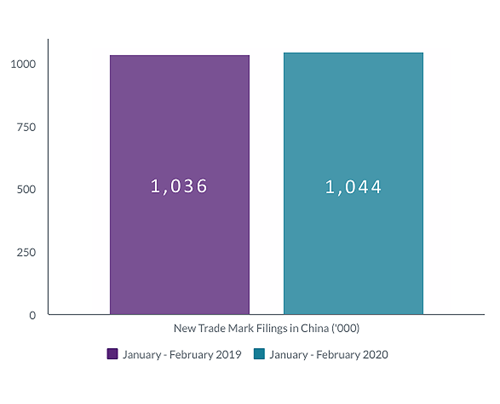We believe there will be minimal impact as opportunistic filers take advantage of the ever-growing ease of filing.
Bad faith filings have long been the bane of trade mark owners wanting to protect their products and services in China. Improvements in law and practice in recent years are welcome, but a halving of the official fee and the introduction of online filing, both in 2017, fueled a massive surge in filing. Twice as many applications were made in 2018 (7.1m) as in 2016 (3.5m), and the numbers continue to grow: in 2019 there were 7.5m applications, more than all of the rest of the world put together. And amongst them, a growing number of bad faith filings.

Source: Rouse Analysis
We have also seen how the COVID-19 crisis has been a fertile hunting ground with more than 1000 COVID-related obvious bad faith filings in February 2020 alone.

The authorities have tried to tackle bad faith filings in the most recent amendments to China’s trade mark law introduced in late 2019 with new sanctions for bad faith filers, including a requirement of an intent to use and penalties for bad faith applications and bad faith litigation. But we expect that Chinese examiners will continue to struggle to identify bad faith filers as their methods become more sophisticated. For instance, bad faith filers are exploiting the low detectability of micro networks: a network of registered companies that all file for trade marks with each entity only making a few applications making them hard to find. So, despite the stricter rules for examinations, we anticipate no let up.
So what can IP managers do?
Bad faith filings are the single most common “business irritant” reported to the British Embassy in Beijing. With many IP managers facing cuts to budgets it is important to step back and consider what immediate actions you can take. These practical steps hopefully go some way to help you prioritise what you can do to protect your intellectual assets now:
Refine your opposition strategy
Given constraints to budget this is the time to review your current strategy and identify those actions which bring real value to the business: which ones are genuinely creating or preserving a key competitive advantage, and which ones are just ‘managing the noise’ to keep a tidy register?
Lower priority applications
Can some third-party applications in lower priority classes go unopposed? Preserve budget now and review the register when your budget returns. Then you may file non-use cancellations or invalidations when third party intentions may be more apparent and so the real risks associated with them can be re-assessed.
Examine your success rates
As part of both the measures above, take time to review historic success rates. Success rates should never be the only metric – the ultimate measure must be value to the business – but it may support a conversation with the business about redrawing the lines of tolerance and accepting higher levels of risk in these exceptional times.
With these practical steps we hope they will go some way to help you prioritise what you can do to protect your intellectual assets now.